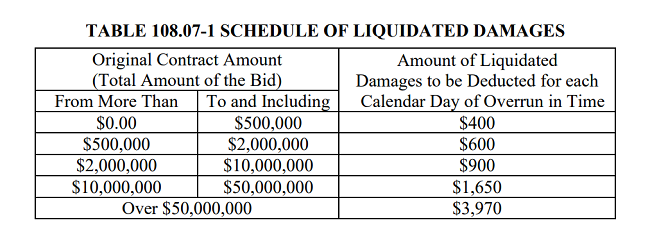Top 10 Construction Contract Terms for 2023
Tom Nocar and I recently completed another annual presentation on “Avoiding Construction Litigation” for the Builder’s Exchange of Central Ohio. A central element of that presentation is walking the audience through our “Top 10” list of construction contract terms to scrutinize (plus some honorable mentions). Following are the 10 terms that, in our view, either most often lead to disputes and litigation, or have the greatest consequences for project participants in the event of litigation.
Without further ado, here are our Top 10 Construction Contract Terms for 2023:
10. Damages provisions
The big three to look out for are consequential damages, liquidated damages and attorneys’ fees.
Many construction contract terms contain a mutual waiver of consequential damages, but be wary of those that don’t or, worse yet, provide for recovery of consequential damages by only one party. Consider the project, too. Because the most common form of consequential damages are lost profits, a contractor faces far greater exposure working on a casino project (huge potential for lost profits) than a school project (no lost profits).
Liquidated damages are common, particularly on government projects where consequential/lost profit damages are difficult or impossible to quantify. The key here is making certain the daily amount is fair, which is most often measured by contract value. For a quick sanity check, take a look at ODOT’s guide. Page 59 includes the following table:

The American rule is that both sides generally bear their own attorneys’ fees unless the contact says otherwise. That is fine. So, too, is a provision that the “loser pays” the other’s attorneys’ fees. But one-sided attorneys’ fees provisions—those that permit only one party to recover if they win or, even worse, permit that party to recover even if they lose—should be very high on the list of “must strike” clauses.
9. Attached exhibits
There’s no magic here, simply a recognition that the contract does not end at the signature page. Most construction contract terms incorporate numerous exhibits into the contract (drawings, owner’s contract, schedule, to name just a few), and we’ve had a few clients surprised to discover that an exhibit contained terms at odds with those in the contract itself (in one very recent case, a one-sided attorney’s fee provision where the contract itself was otherwise silent on the issue).
8. Dispute resolution
If you ask 10 attorneys whether they prefer arbitration or litigation (court or jury trial), you might get five in favor of each. But if you ask 10 construction attorneys which they prefer, nearly everyone will answer arbitration. That’s because the complex and highly-technical nature of most construction disputes are best heard by a construction expert, not a judge or jury who likely know nothing about how, for example, a roof gets built.
Also make sure the contract calls for a convenient forum for the litigation of disputes, though this consideration is of lesser importance in Ohio because state law generally mandates that Ohio construction projects must be litigated in Ohio.
7. Insurance and bonds
Bottom line, have your lawyer and/or insurance agent review the proposed insurance and bonding requirements to make sure that (a) they’re fair and (b) you have the required coverage.
6. Termination/suspension
Many construction contract terms permit the owner or higher-tiered contractor to terminate for convenience (i.e., without cause). That provision is so common in the industry that it is difficult to negotiate it out of the contract entirely. But if that can’t be done you can at least provide yourself a measure of financial protection by providing for the recovery of lost profits in such event (rather than just incurred costs, which is the standard—and often woefully inadequate—recovery). Further, some contracts automatically convert a termination for cause provision into a termination for convenience, should the evidence prove that there was no justifiable cause for termination. This should be negotiated carefully amongst owners and builders.
5. Indemnity
Like provisions calling for the litigation of Ohio projects in other states, Ohio law already addresses the most unfair indemnity problem—an owner or contractor demanding indemnification from another project participant for its own negligence. Such provisions are generally unenforceable. Nevertheless, indemnity provisions demand careful review because of their potentially significant consequences. Attorneys’ fee provisions are often buried here, too.
4. Notice of claims
Nearly every construction contract contains claims notice requirements (form, timing, contents, means of delivery). Nearly every court enforces them (regardless of how many verbal notices you provided and/or what the owner/higher tier contractor assured you). And nearly nobody follows these requirements to the letter (despite their lawyer’s warnings). Many a great claim has died on the vine for failure to read and follow these initial requirements.
3. Payment/delays
Just as important as specifying when you’ll get paid is specifying when you can suspend performance or walk off the job for payment delays. Relatedly, when can you suspend performance for lengthy or repeated project delays? Many clients get stuck on problem jobs with payment and/or project delays because the construction contract terms are not clear as to when exactly the client can walk away, and they fear the consequences of future litigation and damage claims for premature suspension/termination. Make sure the contract is clear about when you can pull the rip cord.
2. Change orders
See notice of claims. Courts generally don’t care what you said to the owner or what you were assured in response. In other words, courts generally don’t care what’s most fair. Courts care what the contract says, and if you don’t follow the change order procedures you can likely wave goodbye to your claim.
1. Scope of work/schedule
This is the most fundamental element of a contract, and the one most likely to lead to disputes. Make sure that your scope of work is clear, concise, complete, correct and coordinated. And make sure that there is a schedule—one that it is clear, with reasonable durations and time frames consistent with what you bid, that it integrates with other work, and that it gets updated as called for in the contract documents.
For more information, please contact Ryan Sherman or any member of Weil Brown’s Construction Practice Group.




